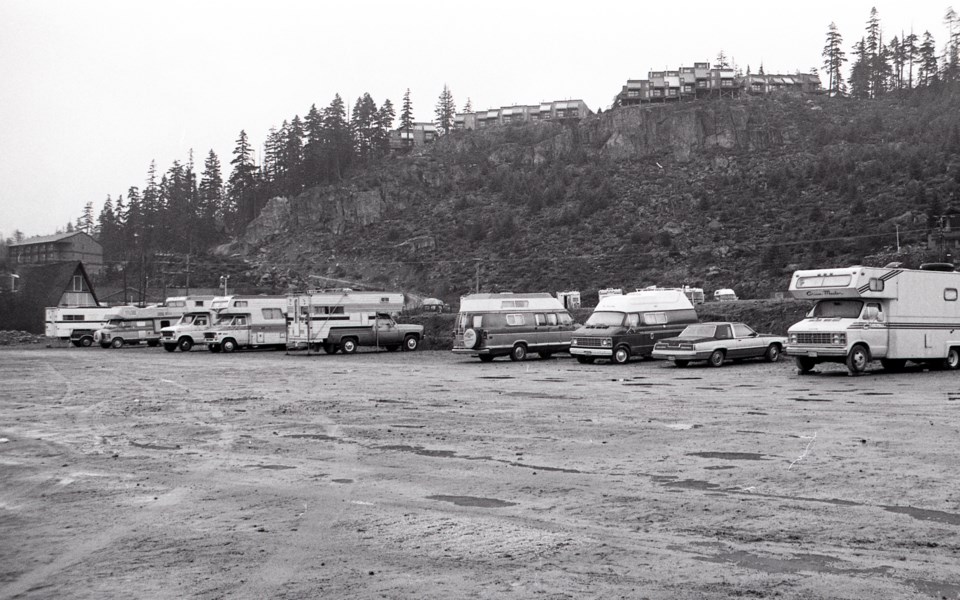The first official campground inside Whistler’s municipal boundaries was the KOA (Kampgrounds of America) Campground, on the land that is now Spruce Grove.
Before the campground opened, people who wanted to camp in Whistler stayed in their campers and cars in the municipal day skier lots and lift company parking lots at Creekside and Blackcomb Base 2, managed by Whistler Mountain and Blackcomb Mountain, respectively.
In 1981, the official position of the municipality was that campers should park overnight at the Alpha Lake Aggregates pit by Function Junction. However, this was a long way from the ski slopes, and campers were found far more often in the parking lots close to the lifts. Extended overnight stays were accepted and, in some cases, welcomed in the parking lots. Blackcomb even installed hookups so campers had electricity while staying in the Base 2 parking lot.
Ruth Buzzard had purchased a 15.2-hectare property running along both sides of Fitzsimmons Creek, north of White Gold, in 1980. After a difficult approval process, the KOA Campground, or Whistler Campground as it became known, finally opened in November 1985.
Whistler Campground billed itself as a year-round camping resort boasting a hot tub, sauna, pond skating rink, hook-ups and a free shuttle bus to the village. To better cater to winter weekenders, the campground allowed visitors to leave their RVs in the overflow parking during the week for a discount, allowing visitors to drive to their campers each week without pulling them up and down the Sea to Sky Highway.
With the campground finally available, parking overnight became illegal in the municipal day skier lots. This was both to encourage campers to move to the campground and to allow plowing of the parking overnight.
Additionally, in 1984, an amendment was made to the zoning bylaw for Rural Resource 1 (RR1) lands which banned overnight stays. Initially, the amended bylaw was not enforced, because campers had nowhere else to go. However, once the campground drew council’s attention to the zoning discrepancy, the no-camping regulation was enforced on all RR1 lands, which included the municipal day skier lots and parking at Blackcomb and Whistler Mountain. Campers were ticketed and threatened with towing in the day skier lots, and gates were put up to prevent overnight campers from accessing the lift company parking lots. Unsurprisingly, it was not a popular decision to stop free ski-in/ski-out camping, and letters of complaint were regularly published in the Whistler Question.
With visitors still choosing to camp elsewhere throughout the winter, keeping the campground open year-round was not economically viable. In 1992, the Whistler Campground started to close for the winter. It was still busy the rest of the year, with its 151 sites regularly hosting more than 600 campers on summer weekends. When the sites filled up, Ruth and the campground team, including her sons David and Mark, would help campers find spots across their large property. There were even stories of enterprising campers setting up on the gravel bar in the middle of the creek when all the sites were filled.
Unfortunately, the campground wouldn’t last. In 1989, Vancouver-based developer Greensides Properties Inc. bought an option-to-buy on the property, giving it exclusive rights to purchase the land in the future. In the early 1990s, the company followed through on its option, deciding to go ahead with the purchase. Despite three appeals to the Supreme Court, Ruth was required to sell the land. According to the Whistler Question, the property was sold for $3 million, plus 35 per cent of the money derived from the redevelopment.
Greensides took over the property in 1996, agreeing with the council of the day to run the campground throughout the summer. With a few approval setbacks along the way, the development of the Spruce Grove subdivision began in 1998.
Whistler went without a campground again until Riverside Campground finally opened in December 1999.





